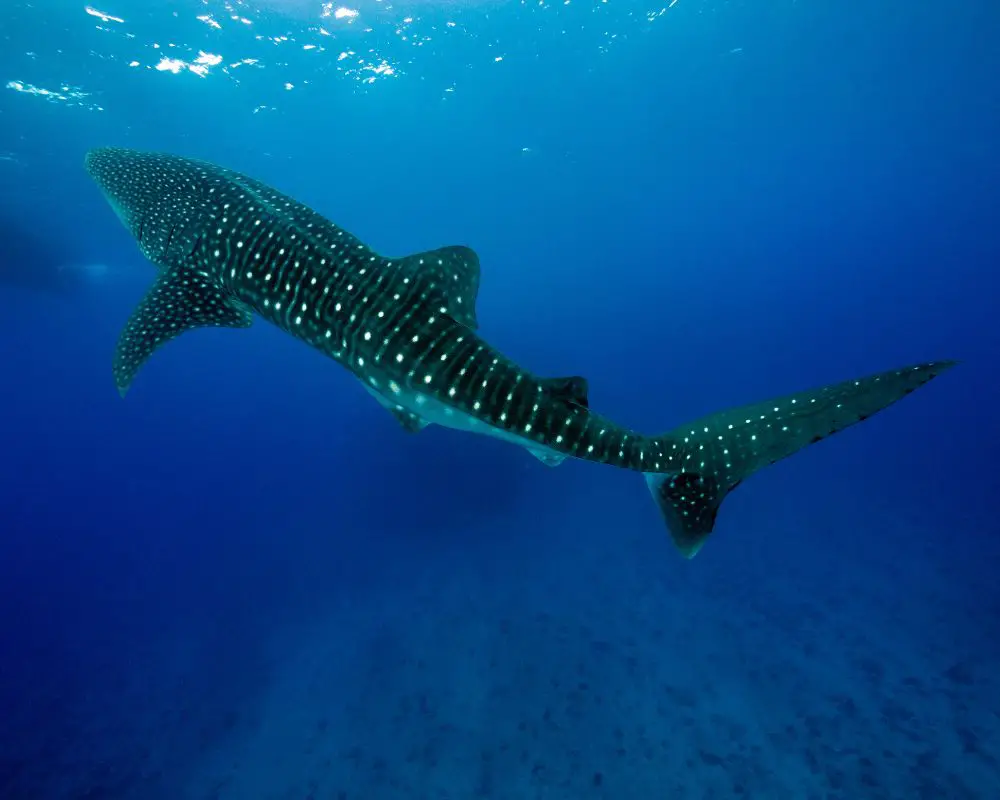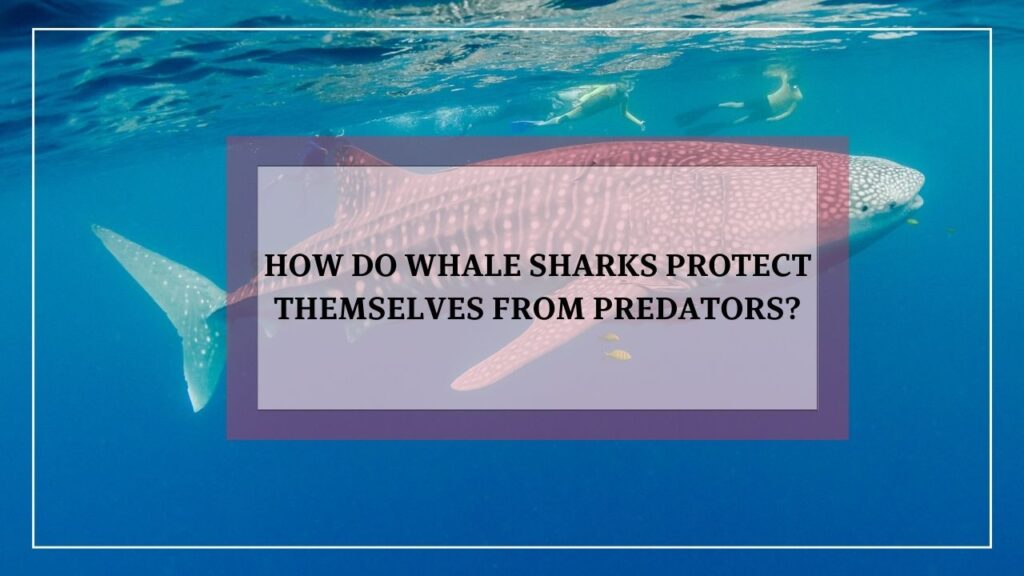Whale sharks are truly magnificent creatures. They are the largest fish in the world, with an average size of around 30 feet and a weight of over 20,000 pounds. Despite their size, they are gentle giants and pose no threat to humans. But have you ever wondered how they protect themselves from their own predators?
In this article, we will explore the different ways that whale sharks protect themselves and dive into the fascinating world of these gentle giants.
Do Whale Sharks Have Predators?
Whale sharks are massive creatures and are known as the largest fish in the sea. With their size and strength, it may seem unlikely that they have any natural predators, but that is not entirely true. Despite their size, whale sharks do have a few predators that they need to defend themselves against.
1. Killer Sharks
One of the primary predators of whale sharks is the killer whale, also known as the orca. Killer whales are known to prey on a variety of marine animals, and even though whale sharks are much larger than orcas, they are not immune to their attacks.
Orcas are intelligent and social predators that hunt in groups and use their strength and agility to overpower their prey. In some cases, they have been observed targeting juvenile or weakened whale sharks.
2. Great White Sharks
Another potential predator of whale sharks is the great white shark. Although they are smaller than whale sharks, great white sharks are known for their aggressive and powerful hunting tactics.
They are apex predators that can hunt a wide range of marine animals, including other sharks. While great whites do not typically hunt adult whale sharks, there have been reports of them attacking juveniles.
3. Humans
Apart from these two, there are not many other known predators of whale sharks. However, as with many other marine animals, humans are a significant threat to their survival. Whale sharks are often hunted for their meat, fins, and oil, and are sometimes caught unintentionally. Pollution, habitat destruction, and climate change are also major concerns that can impact the population of whale sharks.
How Do Whale Sharks Protect Themselves?

In fact, the mechanism involved in protecting whale sharks from their predators consists of 3 parts:
- Physical features that help whale sharks defend themselves.
- A behavioral adaptation that protects whale sharks.
- Natural defenses of whale sharks.
Let’s explain each one of them further.
1. Physical Features Of Whale Sharks That Helps In Self Defense
Whale sharks are the largest fish in the world, and their size plays a significant role in their defense against predators. In this section, we will discuss the physical characteristics of whale sharks and how they use them to protect themselves.
Size And Body Shape
Whale sharks can grow up to 59 feet in length and can weigh as much as 15 tons. Their large size makes them less vulnerable to predators as they are too large to be swallowed whole by most predators. The massive size and girth of whale sharks also make it difficult for predators to bite or grasp onto them, making them less vulnerable to attack.[1]
Male and female whale sharks also differ in their body shape. Male whale sharks have a much thicker and more muscular bodies, while females have a wider body shape to accommodate their reproductive organs.
Skin Texture And Coloration
Whale sharks have a distinctive checkerboard pattern of light spots and stripes on their skin. The pattern varies from individual to individual, and it is believed that it may help camouflage them in their environment. The coloration may also play a role in protection as it helps to break up the outline of their body, making it more difficult for predators to spot them from a distance.
In addition to their coloration, the skin of whale sharks is also covered in small, tooth-like scales called dermal denticles. These denticles make the skin feel like sandpaper and provide a protective layer against parasites and other organisms.
Dentition
Whale sharks have several rows of small teeth located in the back of their mouth. While they are not used for feeding, they may play a role in defense mechanisms. Some scientists speculate that the teeth may be used to grip prey or to inflict a painful bite on predators.
2. Behavioral Adaptations Of Whale Sharks
Whale sharks have evolved a variety of behavioral adaptations to protect themselves from predators. These adaptations allow them to avoid danger and ensure their survival in the open ocean.
Migration Patterns
Migration plays a crucial role in the survival of whale sharks. By moving to different areas of the ocean, they can avoid potential predators and find new sources of food. Some studies suggest that migration may also help to reduce the risk of inbreeding, as whale sharks can mate with individuals from different populations during their travels.
The exact reasons for whale shark migration are still unknown, but researchers believe that a combination of factors may be involved. These include changes in water temperature, food availability, and the need to avoid large predators like killer whales and sharks.
Group Behavior
Whale sharks are social creatures and are often found swimming in groups, or aggregations. These groups can vary in size from just a few individuals to several hundred. When swimming together, whale sharks will often follow a leader, forming a line behind them.
Swimming in groups provides a number of benefits for whale sharks. First, it allows them to share information about food sources and potential dangers. Second, by swimming close together, they can present a larger target to potential predators, making it harder for them to single out an individual.
Whale sharks use a variety of signals to communicate with one another while swimming in groups. These signals can include body language, changes in swimming speed, and even vocalizations. Researchers believe these signals may help the sharks coordinate their movements and avoid collisions while swimming together.
Avoidance Strategies
Whale sharks have developed a number of avoidance strategies to protect themselves from predators. These strategies include diving behavior, the use of hiding spots, and moving into deeper waters.
When threatened by a predator, whale sharks will often dive into deeper waters in an attempt to escape. This behavior can make it more difficult for predators to pursue them, as they may not be able to dive as deeply.
Role Of Hiding Spots And Deep-Sea Dives In Protection
Whale sharks also use hiding spots to protect themselves from predators. These spots can include areas with thick vegetation, underwater caves, or even sunken ships. By hiding in these areas, they can avoid detection and reduce the risk of attack.
Additionally, whale sharks have been known to make deep-sea dives to escape predators. By diving to depths of several hundred meters, they can avoid detection and reduce the risk of attack.
3. Natural Defences Of Whale Sharks
Whale sharks have several natural defenses that they use to protect themselves from predators. These defenses are adaptations that have evolved over millions of years and have helped them survive in their aquatic environment. In this section, we will discuss the natural defenses of whale sharks in detail.
Strength And Durability
Whale sharks are the largest fish in the ocean, and their massive size alone is a form of defense against predators. They have thick, rubbery skin that is up to 4 inches thick in some areas, and their skeletons are made of cartilage instead of bone, which makes them more durable.
Their skin is covered in dermal denticles, which are small, tooth-like scales that provide an extra layer of protection against predators. The cartilage in their skeletons is stronger than bone, making it more resistant to damage from impacts.
Their strength and durability help them withstand attacks from predators, such as other sharks or killer whales. They can also use their massive size to fend off potential threats.
Camouflage And Mimicry
Whale sharks have a unique pattern of white spots and stripes on their skin that helps them blend in with the surrounding water, a form of camouflage called countershading. This pattern also helps break up their silhouette, making them harder to see from below.
Countershading is a common form of camouflage in many aquatic animals, and it helps conceal the animal’s true shape and size from potential predators. In the case of the whale shark, it makes them less conspicuous in the water and helps protect them from predators that hunt from below.
Whale sharks have also been observed exhibiting mimicry behavior, where they imitate the swimming behavior of other animals, such as manta rays or schools of fish. This behavior may help them avoid detection by potential predators or help them get closer to their prey without being noticed.

